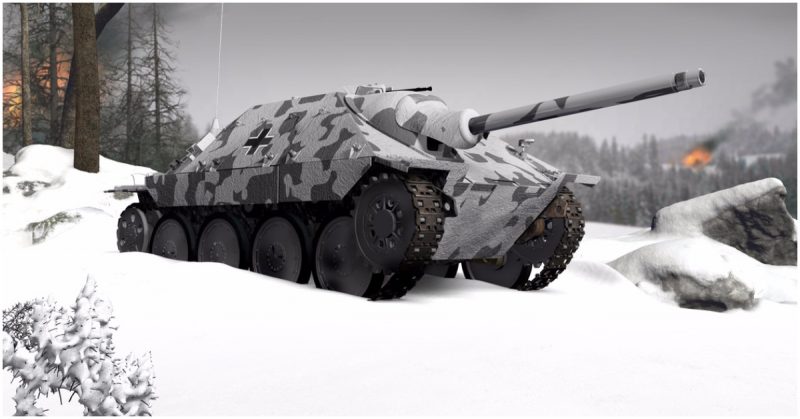The tank destroyer is not really a tank, and an armored assault gun is also not really a tank which can be confusing to some students of history.
That said, war planners and strategists and tactical maneuver geniuses saw a distinct advantage in putting as many heavy guns on a battlefield as possible. When WWII broke out, pretty much only the Wehrmacht had developed a new kind of war tactic where fast-moving tanks could spearhead an opening in enemy lines to enable infantry to storm through.
For almost everyone on the Allies side, tank doctrine still saw tanks as primarily infantry assault support vehicles. Tanks initially were thinly armored cars with heavy machine guns, a mobile pillbox of sorts. They knocked out other machine gun nests, redoubts, field guns and of course infantry.
They worked wonderfully. There was almost no situation when it was pleasant to find oneself at the business end of a mounted heavy machine gun on a tank.
However, the fast-moving Panzer Mark III and the Panzer Mark IV had not only machine guns; they had 50mm cannons on them. So planners decided that German medium tanks should be confronted with not only tanks that could destroy them, but with machines designed specifically to hunt other tanks.
The Axis powers had produced Main Battle Tanks that could support infantry, yet with guns big enough to knock out other tanks.
The Allies had to catch up. The arms race in tanks was on.
The Germans were efficient, and they began putting hard-hitting anti-tank guns on an obsolete tank chassis, producing a Tank Lite. All the killing power of a typical tank, but one-third the armor protection. The Germans had thousands of 76mm high-velocity guns and shells that could do damage to or eliminate almost every tank in the opposing skirmish line.
If there was a tank battalion with 20 tanks, and ten extra 76mm guns, with a range of up to 1200 meters, they could be used to secure their flanks from tanks racing in for a counter-attack from behind or the side. These small tanks could be camouflaged and used to ambush enemy tanks.
The armored assault gun could dish it out, but it did not really have the armor to take it.
Most American, British, and Russian tanks destroyed on the battlefield were most likely taken out by an armored assault gun. Stugs took out more Shermans than Tiger tanks did. German Nashorns, Elefants, and Hetzers destroyed more T-34s than Panther tanks. The Allies wasted no time creating their own long-range tank snipers, and ambush guns: the SU 122mm, the M18 Hellcat, the 90 mm M36 Gun Motor Carriage, and so forth.
That said, here are the big German tank destroyers.
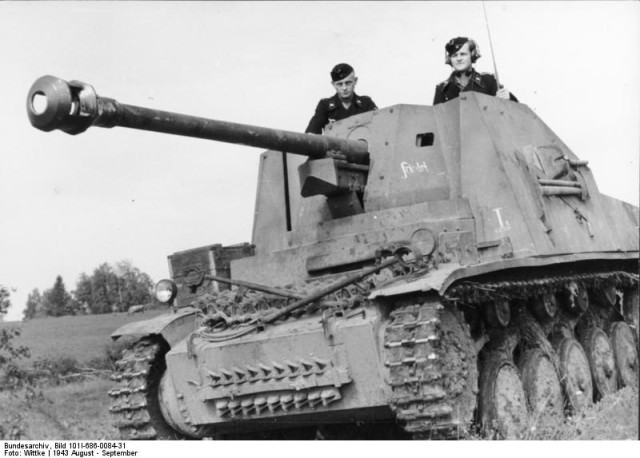
The Marder
The Marder Series were some of the German armored assault guns used to support infantry advances and secure the flanks of armored assemblies. They had a citadel style or open turret design. Soldiers really did not like the fact that gun operators were exposed to shrapnel and small arms fire. Some models sported the lethal high-velocity 76mm Pak gun or the 75mm Pak 40. This diesel powered mobile gun was placed on the reliable Czechoslovak LT-38 chassis.
There was exactly 1,736 of the Marder III built. They saw action on the Eastern front and in Tunisia. Their 50mm armored glacis plating was insufficient to withstand a round fired even from the short barreled 75mm of a Sherman or anything larger.
The Marder III also suffered from a high profile, and it required a crew of 4 men.
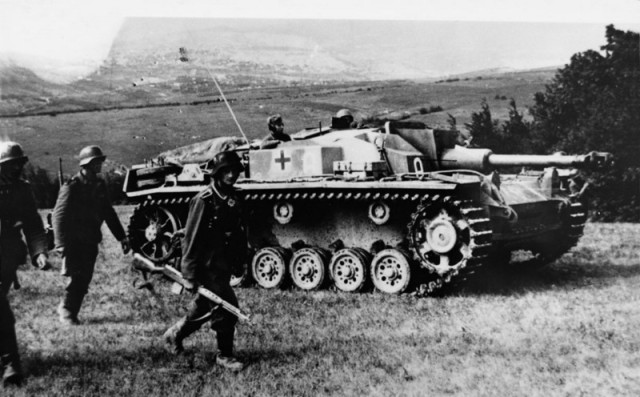
The Sturmgeschütz Series
Germany made more Sturmgeschütz anti-tank guns than they made Panther IV tanks. Over 11,000 of the mobile guns were manufactured. Only 8,000 Panthers made it off the assembly lines. The Stug for short was a series of mobile assault guns that saw much action in WWII. The Stug III was built on the Panzer III Chassis. The Stug IV was built on the Panzer IV chassis.
This odd ‘tank’ did not have a traversable turret. The advantage was that they took less time to produce and then get them to the battlefield. The disadvantage was that the tank had to be steered to the left or right to aim. That meant the engine had to be on, which might give away an ambush position. So the Stug, while extremely effective, was a defensive armored vehicle used as support and ambush.
The Stug had a gas engine, and a low profile and its gun could knock out anything the Allies could field. In fact, German armored divisions could block holes in their lines with Stugs. This vehicle spat death all over the killing fields of Kursk and Moscow with its 7.5 cm StuK 40 L/48 gun and high-velocity armor-piercing shell.
About 1,100 Sturmgeschütz IVs were built, utilizing sloped armor on the Panzer IV chassis. It was so heavy that after the first run all production was halted.
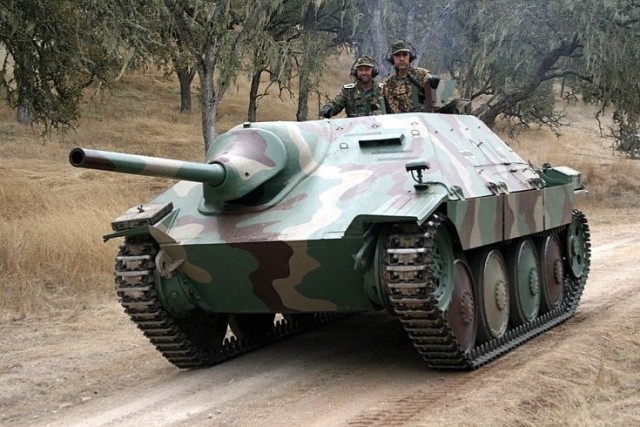
Hetzer Jagdpanzer 38 D
The Hetzer was a mobile 75mm high-velocity anti-tank gun mounted on a widened Czechoslovak light tank chassis and 7.92mm machine gun operated from inside the vehicle. Some 2,800 were built, mostly by Skoda in 1944 and 1945.
It had a crew of four and a gas engine. It suffered from insufficiently thick side armor, limited ammunition storage, little or no gun traverse, and an odd configuration that made operating the vehicle difficult.
That said, on the Eastern front, there is a report of a company of Hetzer mobile guns destroying 20 Russian tanks without a single loss. The Hetzer was not designed to trade with main battle tanks, but used as an ambush vehicle or backup for armored divisions it fared well.
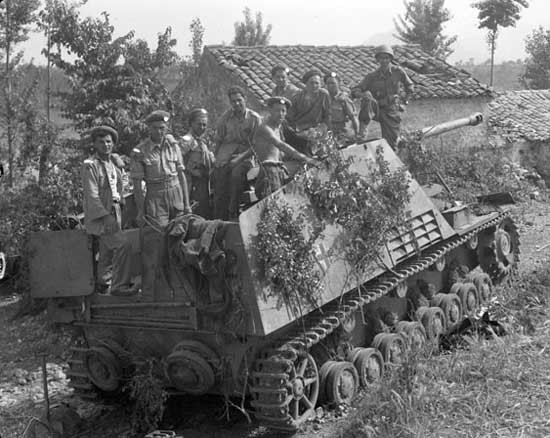
The Nashorn
The Pak 43 88mm gun was the tank killer of all time. It was Rommel who discovered in the deserts of North Africa that the anti-aircraft 88mm guns could be turned horizontally and used quite effectively against armor. Mounted on the Mark VI chassis, the Nashorn was first given the name Hornisse (Hornet).
Hitler renamed it the Nashorn (Rhinoceros) and off it went into battle. Its 88mm gun was feared by all and used effectively in the East against heavy Soviet Josef Stalin tanks and super heavy KV-1 and KV-2 tanks.
It had enough armor to be used as a tank but was mostly employed as an ambush gun. Its high profile made it hard to hide, but the Nashorn’s 88mm gun was capable of penetrating 190 mm of armor at half a mile.
Four or five men could operate it effectively. Just 473 were made.
It saw action from North Africa to Kursk and was famous for its long-distant kills.
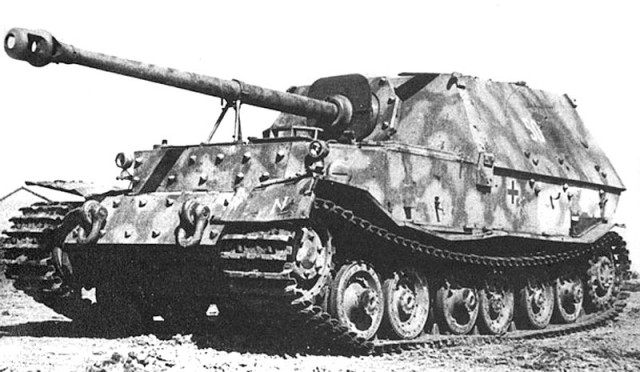
The Elefant Panzerjager
It began as the Ferdinand named after Mr. Porsche, the famous car designer. The Germans built 91 of these tank destroyers. It featured the famous 88mm Pak gun and a 7.62mm MG-34 machine gun. This particular 88mm gun was designed to fire an extended shell, at a longer range and it was a far more powerful round.
It’s 200 mm of armor made it rather tough on the battlefield, and thus, it could go head to head with most Allied tanks. It was installed on the Panzer Mark VI Tiger One chassis.
It weighed in at 65 tons and had a profile almost ten feet tall. It was an easy target for anti-tank guns in Italy and at the battle of Kursk. Russian infantry that could get close enough destroyed many of these guns by swarming over them with charges and incendiaries. The first versions lacked a machine gun for self-defense.
One Ferdinand of the 653 Heavy Tank Destroyer Battalion traded with Soviets at Kursk and counted for 320 armored vehicle hits for the loss of just over a dozen Ferdinands.
Like the Jagdtiger and the Nashorn, these guns were very heavy and plagued with mechanical problems. Their own crews scuttled most that were destroyed.
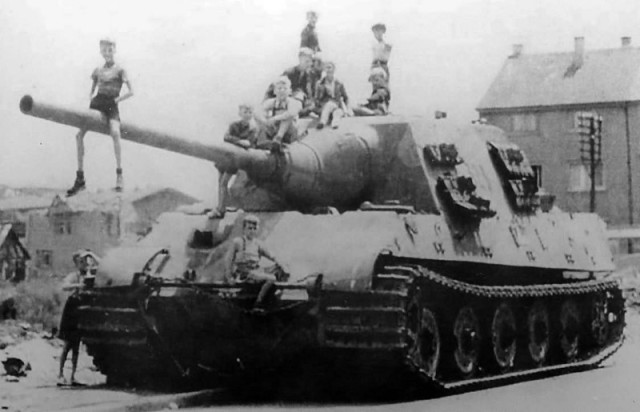
The Jagdtiger
This monster German tank destroyer featured a 128mm gun that could stop any armored vehicle on the battlefield and penetrate almost any bunker. The Germans made 88 of them and deployed them as fast as possible. All of them had to be transported by rail because they were 128,000 pounds and few bridges could hold them.
On the battlefield, they performed quite well. Their 250 mm of front glacis armor was almost impenetrable. Once, three Jagdtigers took out a dozen US armored vehicles in just a few minutes from a hidden hull down position in 1945 fighting in the Ruhr pocket. Shermans destroyed a few Jagdtigers when they exposed their thinly armored sides.
Maintaining these Juggernauts was a nightmare. The gun needed to be recalibrated after driving for a long time. A crew member had to leave the vehicle and unlock the barrel ring. The massive 128 mm gun had to be loaded in two pieces, the shell, and the firing charge which slowed the rate of fire down.
The gun was casemate style so traversing the barrel had to be done by steering. Most Jagdtigers were destroyed by their own crews when they ran out of gas, or ammo. Many just broke down and could not be repaired. The cabin filled with smoke after the gun was fired which was too much to bear and had to be vented which gave the Jagdtiger’s position away.
It was vulnerable to Allied air cover, and by the time the 50 or so that were manufactured reached the battlefield, the Allies owned the skies.
The Jagdtigers destroyed about 50 US armored vehicles mostly Shermans, many from ranges up to 4,000 meters.
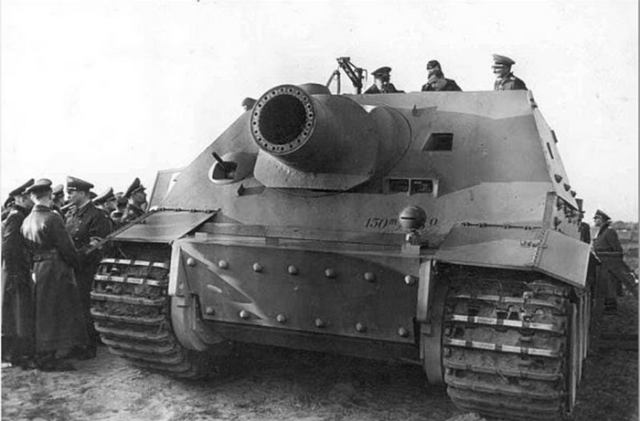
The Sturmtiger
It was a weapon that could demolish sniper hiding structures with a single shot. It had a telescopic sight and was armed with a 380 mm breech loading rocket launcher and mortar. It could fire projectiles ¾ of a mile away.
The 275-pound shaped-charge “raketen hohladungsgranate 4582” was used against fortifications and could penetrate 8 feet of reinforced concrete. Each shot could bring down a building. It only carried 14 of these long rockets or mortars, though.
The launching charge was so powerful exhaust gasses had to be vented through special ducts. A tremendous flash accompanied each firing meaning the vehicle had to be moved as the flash revealed its position.
The ammunition was so deadly and technical that the best estimate for production capacity was 300 rounds – a month.
The Sturmtiger was a German assault gun built on the Panzer Mark VI Tiger I chassis. The idea was to create an infantry assault support vehicle specifically to destroy heavily defended pillboxes and buildings.
It not only had a 380 mm rocket launcher, but it also had a 100 mm grenade launcher and a 7.92mm machine gun. The 380 mm rocket launcher was adapted from the Kriegsmarine naval depth charge launcher.
The Sturmtiger weighed 65 tons and featured reasonably heavy 150 mm thick and sloped armor. It was designed for close-in urban fighting around infantry battalions, and it required five crew members to operate. The Sturmtiger was used in the Warsaw uprising and the defense of Remagen.
Just 19 of them were built.
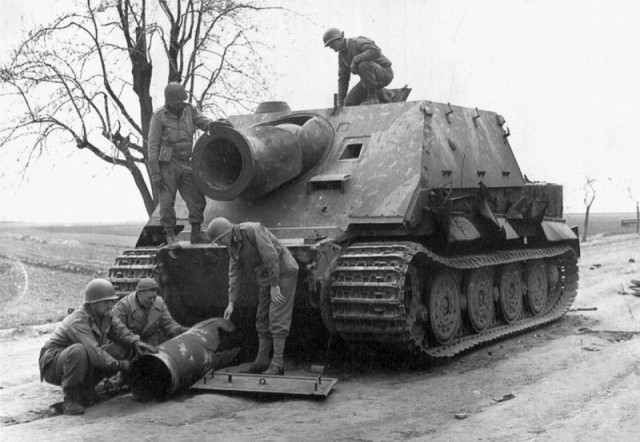
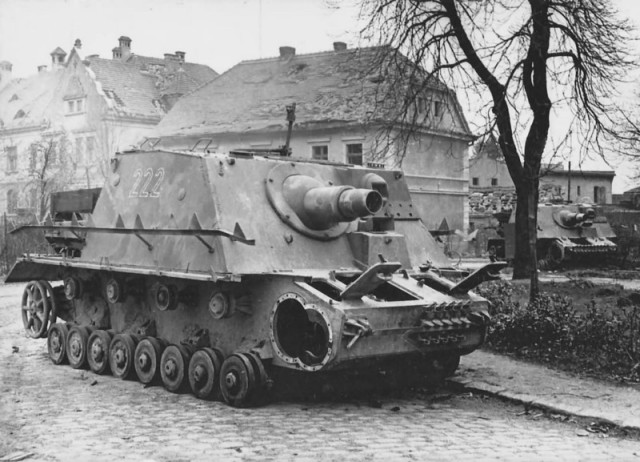
The Sturmpanzer
The Sturmpanzer IV or Brummbår was also an assault gun designed to knock buildings down. It featured a 150mm or 6-inch gun and carried 38 of the massive rounds. It was not intended as an anti-tank gun. It was an anti-real estate round.
The Germans put this gigantic field gun on the Panzer IV chassis and apparently that was not big enough for the StuH L/12 gun, and the first model suffered terrible breakdowns. The Germans then put a lighter 150mm gun on the chassis, and that tank was used to put down the Warsaw Uprising.
They were able to manufacture 306 of them before the war ended. It housed five crew; a commander, a gunner, a driver and two loaders. It also featured a 7.62mm machine gun on the armored citadel. Bad ventilation affected the crew, and they often had to leave the firing cabin after firing a few shells.
The Sturmpanzer was used at Operation Citadel, the massive two-pronged assault on the Kursk Salient. It was seen at Normandy and in the Warsaw uprising. It was manufactured from 1943 to 1945.
Historians have discussed the low number of German tanks manufactured because they were sufficiently complex to warrant months to build each one. The Germans were experimenting with anti-tank guns and old chassis promiscuously and creatively.
The era of the mobile anti-tank gun as a sort of ersatz tank is over. Today’s manually operated anti-tank missiles make the Panzerfaust look moribund, and new anti-tank weapons make the individual soldier as deadly as a tank.
By Daniel Russ
